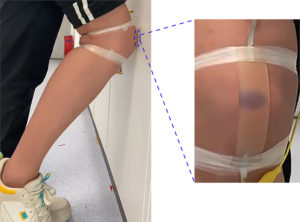ACS Applied Materials & Interfaces

An artificial skin attached to a person’s knee develops a purple “bruise” when hit forcefully against a metal cabinet. Credit: Adapted from ACS Applied Materials & Interfaces 2021
When someone bumps their elbow against a wall, they not only feel pain but also might experience bruising. Robots and prosthetic limbs don’t have these warning signs, which could lead to further injury. Now, researchers reporting in ACS Applied Materials & Interfaces have developed an artificial skin that senses force through ionic signals and changes color from yellow to a bruise-like purple, providing a visual cue that damage has occurred.
Scientists have developed many different types of electronic skins, or e-skins, that can sense stimuli through electron transmission. However, these electrical conductors are not always biocompatible, which could limit their use in some types of prosthetics. In contrast, ionic skins, or I-skins, use ions as charge carriers, similar to human skin. These ionically conductive hydrogels have superior transparency, stretchability and biocompatibility compared with e-skins. Qi Zhang, Shiping Zhu and colleagues wanted to develop an I-skin that, in addition to registering changes in electrical signal with an applied force, could also change color to mimic human bruising.
The researchers made an ionic organohydrogel that contained a molecule, called spiropyran, that changes color from pale yellow to bluish-purple under mechanical stress. In testing, the gel showed changes in color and electrical conductivity when stretched or compressed, and the purple color remained for 2–5 hours before fading back to yellow. Then, the team taped the I-skin to different body parts of volunteers, such as the finger, hand and knee. Bending or stretching caused a change in the electrical signal but not bruising, just like human skin. However, forceful and repeated pressing, hitting and pinching produced a color change. The I-skin, which responds like human skin in terms of electrical and optical signaling, opens new opportunities for detecting damage in prosthetic devices and robotics, the researchers say.
The authors acknowledge funding from the National Natural Science Foundation of China, the Program for Guangdong Introducing Innovative and Entrepreneurial Teams, Shenzhen Science and Technology Program, 2019 Special Program for Central Government Guiding Local Science and Technology Development: Environmental Purification Functional Materials Research Platform, Shenzhen Key Laboratory of Advanced Materials Product Engineering and the CUHK-Shenzhen Presidential Fund.





Tell Us What You Think!